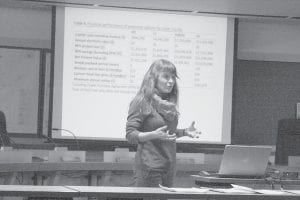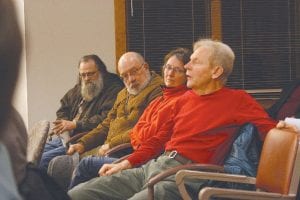The many players involved in researching the feasibility of implementing new biomass technology on a large scale in Cook County met with the public on December 11 to review the results of their work so far.
Cook County Local Energy Project (CCLEP) Biomass Coordinator Gary Atwood gave an overview of the first research phase, funded by Cook County. Atwood said it revealed that “the amount of biomass in the county far exceeds any projected use of biomass in Cook County.”
The second phase, funded by the Legislative-Citizen Commission on Minnesota Resources, produced a list of biomass systems that might be workable in Cook County, ranging from woodstoves in homes to biomass systems for resorts or small clusters of businesses to the current large-scale system being investigated right now—a district heating plant that would serve numerous government buildings in Grand Marais as well as selected businesses on the east side of the downtown business district.

Kathryn Fernholz of Dovetail Partners elaborates on numerous factors addressed in background reports and summary fact sheets that comprise the Cook County Phase II Biomass Energy Study that Dovetail Partners will complete at the end of 2012. Links to these reports can be found at Dovetail’s web site (www.dovetailinc.org) and will be posted on the CCLEP web site (www.cookcountylep.org).
Environmental impacts
Katie Fernholz, executive director of Dovetail, a nonprofit agency instrumental in the research, said that new technologies over the last several decades have greatly increased the efficiency and practicality of biomass energy, producing better results both economically and environmentally. Biomass energy could be used successfully in numerous ways in Cook County, she said, but getting the right systems in place would be crucial.
While sustainable forestry practices allow much less than 50 percent of harvest residue to be left on the forest floor, the models used in studying the potential of biomass energy in Cook County assume that 50 percent of harvest residuals would be left behind. Fernholz, who previously worked in the field of sustainable forestry certification, said Minnesota timber harvest rates are at a 30-year low, but even using harvest residuals from this low harvest rate would provide enough biomass for the uses Cook County is investigating. She said that the logging industry has multiple layers of oversight and would expect the proposed biomass district heating plant to help improve the health of the forest.
Fernholz said the environmental impact of biomass energy is measured in many different ways. For example, a lump of coal is very dense and produces fewer emissions than a same-size piece of wood. Different types of biomass have different impacts on the environment. Biomass pellets burn very efficiently, but the fact that Cook County has no pellet factory means that importing pellets for a district heating plant would have more environmental impact than using wood chips harvested locally. The amount of particulates from biomass heating units varies—a wood fireplace “is like having a bonfire in your house,” Fernholz said, but modern biomass boilers with “multi-cyclone electrostatic precipitators” are very efficient and produce few particulates.
Importing oil from other countries involves very long-distance transportation, requires military security, and impacts the land from which the oil is harvested. “Everything has impact,” said Fernholz. Different fuels rank differently on factors like particulates, greenhouse gases, and public health impacts.
“What we really don’t want,” said Cook County Soil & Water Conservation District board member Jesse Derscheid, “is a barrel stove biomass heating plant.”
Cook County property owner Bill Middlefelt of Minnesota’s Clean Energy Resource Teams said the Minneapolis Star Tribune had recently published a frontpage article saying that a crisis was brewing in Minnesota’s forests that would erupt if the state didn’t start cleaning them up. The proposed biomass technology has been in wide use in Europe for 20 years, he said. “We’re not reinventing the wheel here.”
Economic feasibility
Gregg Mast of the BioBusiness Alliance of Minnesota said, “We really see a lot of exciting possibility for a biomass district heating system here in Grand Marais.” He and Mark Spurr of FVB Energy are gathering the information that would be needed to make application to potential funding sources.
Mast said they are investigating whether potential customers could adapt their buildings to the proposed hot water heating system. They are investigating the willingness of potential customers to sign the 20-year contracts that would be necessary for bond funding. They are finding out where the bedrock is as they try to identify a piping route that would work.
The model being pursued would not require customers to invest capital to hook up to the system or pay any more than they are paying now for heat. Being connected to the system is expected to eventually cost less than fuel oil or propane. “The potential savings to the community could be enormous,” said Spurr. They are trying to build in room for the plant to be used by more and more customers in the future.
Spurr said he was “cautiously optimistic” that they will find a way to make the project work financially, although it hasn’t been easy. He expects to get this part of the work done by mid-January. The cost of constructing the plant has been estimated at around $8 million. When asked whether the customer base would be able to sustain the cost of operating and maintaining the plant if the cost of constructing it were covered, Spurr said, “Absolutely.”
Mast said that in communities that have biomass energy plants, the owners of the systems are often the people involved in the supply chain. Spurr said some local businesses are interested in providing biomass for the plant. They are currently analyzing the growth in local jobs that could be expected with the development of a local biomass industry.
According to Mast, communities that have built biomass plants are seeing great increases in tourism as people from other places come to check them out.
Spurr advised community members to “stay tuned.”



Loading Comments